Papers by Hasbullah Thabrany

Proceedings of the 1st International Conference for Health Research – BRIN (ICHR 2022), 2023
Cost information is important for efficiently allocating healthcare expenditures, estimating futu... more Cost information is important for efficiently allocating healthcare expenditures, estimating future budget allocation, and setting user fees to start new financing systems. Indonesia has a very high number of COVID-19 cases. Because of new instances, Indonesia requires information on the cost of COVID services, one of which is information on the cost of COVID-19 treatment medicine. This study assesses the cost of medical services for COVID-19 patients in public and private hospitals based on the severity from the provider's perspective. This study also analyses variations in the price of COVID-19 treatment medicine based on the type and class of hospital to allocate and manage the budget appropriately. A hospital-based cross-sectional study was conducted in 9 public and 7 private hospitals spread across 5 provinces in Indonesia for the financial year 2020. The activity-based costing method was applied to calculate the unit cost of the cost of drugs for inpatient covid-19 treatment per episode of disease according to severity. Costs are calculated using Microsoft Excel 2010. The differentiating factor for patient care in hospitals for COVID-19 patients is the severity level. The average cost of medicine for COVID-19 patients with mild symptoms in government hos
Value in Health, Oct 1, 2017
A899 in Hungary in 2015. We found that the rate of the above interventions was the highest in spe... more A899 in Hungary in 2015. We found that the rate of the above interventions was the highest in specialized hospitals (98.82%). The rate of the achievable same-day surgery's case number was 60.03% in university clinical centers, which is lower than that in county hospitals (61.38%) and the city hospitals (66.90%), on the other hand, it is higher than the rate of Budapest's hospitals (55.49%), children's hospitals (50.66%), and national health care institutes (28.23%). ConClusions: Our results showed that in 2015 the specialized hospitals performed the most, while the national health care institutes performed the least case numbers regarding same-day surgeries in Hungary. PHP5 Funding new TecHnologies in german inPaTienT care-does iT work?

The Lancet Regional Health - Western Pacific
Summary Background In 2014, Indonesia launched a single payer national health insurance scheme wi... more Summary Background In 2014, Indonesia launched a single payer national health insurance scheme with the aim of covering the entire population by 2024. The objective of this paper is to assess the equity with which contributions to the health financing system were distributed in Indonesia over 2015 – 2019. Methods This study is a secondary analysis of nationally representative data from the National Socioeconomic Survey of Indonesia (2015 – 2019). The relative progressivity of each health financing source and overall health financing was determined using a summary score, the Kakwani index. Findings Around a third of health financing was sourced from out-of-pocket (OOP) payments each year, with direct taxes, indirect taxes and social health insurance (SHI) each taking up 15 – 20%. Direct taxes and OOP payments were progressive sources of health financing, and indirect tax payments regressive, for all of 2015 – 2019. SHI contributions were regressive except in 2017 and 2018. The overall health financing system was progressive from 2015 to 2018, but this declined year by year and became mildly regressive in 2019. Interpretation The declining progressivity of the overall health financing system between 2015 – 2019 suggests that Indonesia still has a way to go in developing a fair and equitable health financing system that ensures the poor are financially protected. Funding This study is supported through the Health Systems Research Initiative in the UK, and is jointly funded by the Department of International Development, the Economic and Social Research Council, the Medical Research Council and the Wellcome Trust.
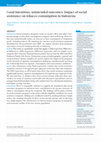
Tobacco Induced Diseases, 2021
INTRODUCTION Social assistance programs create an income effect that allows lowincome groups to r... more INTRODUCTION Social assistance programs create an income effect that allows lowincome groups to raise their consumption to improve their well-being. However, this may unintentionally induce an increase in their consumption of temptation goods, including tobacco. By analyzing five massive social assistance programs distributed by the government since 2007, we explore whether those programs may induce increased smoking intensity in Indonesia. METHODS This study is a quantitative study that applies a Tobit regression, Differencein-Differences (DiD) regression, Difference regression, and two-sample t-test, using the 2017 Susenas (National Socioeconomic Survey) and the 2007 and 2014 Indonesia Family Life Survey. Estimations using sociodemographic, regional, and social assistance dummy variables are used to explore the impact of the programs on the intensity of cigarette consumption in Indonesia, simultaneously assessing the relationship between cigarette consumption and socioeconomic conditions. RESULTS Our estimations using Tobit regressions confirm that social assistance recipients consume 3.39 cigarettes per capita per week more than non-recipients. The DiD regressions on IFLS panel data show that social assistance programs significantly increase cigarette consumption by 2.8 cigarettes per capita per week. We also find that: 1) smokers have lower socioeconomic indicators than nonsmokers in terms of nutrition and health and education expenditures, and 2) younger household members living with smokers have less educational attainment and higher average sick days. CONCLUSIONS There is reasonable evidence to support the hypothesis that social assistance programs in Indonesia have contributed to the greater intensity of tobacco consumption among the recipients. The findings call for policy reforms in social assistance programs to be warier with the eligibility conditions for social assistance recipients. Adding new conditions related to smoking behaviors might reduce the smoking intensity of those in low-income groups and, in the long run, might improve the effectiveness of social assistance programs in raising the socioeconomic welfare of the low-income population.
Journal of Global Oncology, 2018
Background: Indonesia integrated all social health insurance and social assistance program into t... more Background: Indonesia integrated all social health insurance and social assistance program into the National Health Insurance Scheme (NHIS) aiming to achieve universal health coverage by 2019. Currently, 194 million people are registered in the NHIS. Lung cancer absorbed a significant amount of the NHIS Indonesia and one of the leading cause of deaths among men in Indonesia. Lung cancer is rising major public health concern due to a high prevalence of smokers yet most lung cancer is diagnosed at late stage leading to short survival rate in Indonesia. Aim: This study aimed at investigating access, utilization, and clinical outcomes of lung…
BMC Research Notes
Objective Continuous ambulatory peritoneal dialysis (CAPD) and hemodialysis (HD) are main modalit... more Objective Continuous ambulatory peritoneal dialysis (CAPD) and hemodialysis (HD) are main modalities for end stage renal disease (ESRD) patients, and those have been covered by National Health Insurance (NHI) scheme since 2014 in Indonesia. This study aims to update the cost-effectiveness model of CAPD versus HD in Indonesia setting. Results Compared to HD, CAPD provides good value for money among ESRD patients in Indonesia. Using societal perspective, the total costs were IDR 1,348,612,118 (USD 95,504) and IDR 1,368,447,750 (USD 96,908), for CAPD and HD, respectively. The QALY was slightly different between two modalities, 4.79 for CAPD versus 4.22 for HD. The incremental cost-effectiveness ratio (ICER) yields savings of IDR 34,723,527/QALY (USD 2460).

Health Insurance
The world leaders have committed to achieve universal health coverage as set on the goal of 3.8 o... more The world leaders have committed to achieve universal health coverage as set on the goal of 3.8 of the SDGs by 2030. Only public financing could achieve UHC for everyone in a country. There are three sources of public financing, i.e., tax-funded or national health service system, social health insurance applied national or national health insurance scheme, and a combination of the two. Low- and middle-income countries are often easier to start with social health insurance schemes with multiple and single schemes. The option of a single-payer National Health Insurance scheme has a lot of advantages in terms of effectiveness, efficiencies, and equitable health financing for all people in a country. This chapter explains the rationales of health financing and options of public financing with various levels of the impacts on the people in particular and the country. A single-payer system facilitates easy understanding and ensures equitable access with the same benefits for everybody. A ...
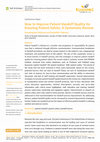
KnE Life Sciences, 2018
Patient handoff is defined as a transfer and acceptance of responsibility for patient care that i... more Patient handoff is defined as a transfer and acceptance of responsibility for patient care that is achieved through effective communication. Communication breakdown in handoff procedures can lead to serious impacts in the patient's care, inappropriate treatment, and potential harm to the patient. The aim of this systematic review is to know barriers in handoff process and find strategies to improve patient handoff quality for ensuring patient safety. The current study is systemic review with PRISMA method, retrieved from online databases such as ProQuest and PubMed using keywords 'patient handoff' OR 'patient handover' AND 'patient safety'. The period of the study that has been reviewed is three years backwards. Based on this review, potential barriers that can lead to handoff failure are lack of standardized handoff tool, lack of chances for face-to-face communication and the ability to interactive discussion, and lack of staff training and handoff supervision. Several improvement strategies to increase patient handoff quality based on this review are: implementation of standardized verbal and written handoff protocols, face-to-face interaction with active discussion opportunities, minimal interruptions, accurate and up-to-date information with critical issues highlighted, staff education and training, handoff process supervision, leadership and regulation support. Improvements or impacts on patient safety were only stated in three journals. Barriers in handoff process must be addressed to find recommendation for handoff process improvement. By addressing barriers, patient handoff quality can be increased by several improvement strategies. Further studies are needed to prove the impact of effective patient handoff in reducing sentinel and adverse events.
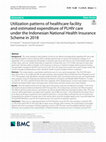
BMC Health Services Research
Background This study analyzed current patterns of service use, referral, and expenditure regardi... more Background This study analyzed current patterns of service use, referral, and expenditure regarding HIV care under the National Health Insurance Scheme (JKN) to identify opportunities to improve HIV treatment coverage. As of September 2020, an estimated 543,100 people in Indonesia were living with HIV, but only 352,670 (65%) were aware of their status, and only 139,585 (26%) were on treatment. Furthermore, only 27,917 (4.5%) viral load (VL) tests were performed. Indonesia seeks to broaden its HIV response. In doing so, it intends to replace declining donor-funding through better coverage of HIV/AIDS services by its JKN. Thus, this study aims to assess the current situation about HIV service coverage and expenditure under a domestic health-insurance funded scheme in Indonesia. Methods This study employs a quantitative method by way of a cross-sectional approach. The 2018 JKN claims data, drawn from a 1% sample that JKN annually produces, were analyzed. Nine hundred forty-five HIV pat...
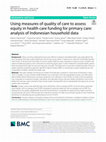
BMC Health Services Research
Background Many countries implementing pro-poor reforms to expand subsidized health care, especia... more Background Many countries implementing pro-poor reforms to expand subsidized health care, especially for the poor, recognize that high-quality healthcare, and not just access alone, is necessary to meet the Sustainable Development Goals. As the poor are more likely to use low quality health services, measures to improve access to health care need to emphasise quality as the cornerstone to achieving equity goals. Current methods to evaluate health systems financing equity fail to take into account measures of quality. This paper aims to provide a worked example of how to adapt a popular quantitative approach, Benefit Incidence Analysis (BIA), to incorporate a quality weighting into the computation of public subsidies for health care. Methods We used a dataset consisting of a sample of households surveyed in 10 provinces of Indonesia in early-2018. In parallel, a survey of public health facilities was conducted in the same geographical areas, and information about health facility infr...
Journal of Family and Economic Issues
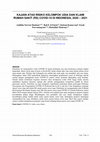
Jurnal Ekonomi Kesehatan Indonesia
Penelitian ini menganalisis risiko COVID-19 untuk kelompok usia dan korelasinya dengan tingkat ke... more Penelitian ini menganalisis risiko COVID-19 untuk kelompok usia dan korelasinya dengan tingkat keparahan, durasi rawat inap (Length of Stay/LOS), klaim rumah sakit, dan status keluar pasien rawat inap rumah sakit. Definisi dari kelompok usia adalah dari anak-anak, usia produktif, dan usia lanjut. Pertengahan tahun 2020 pemerintah Indonesia menetapkan pembatasan sosial di beberapa daerah seiring dengan peningkatan kasus COVID-19 namun situasi ekonomi diharapkan tetap berjalan. Namun dalam melakukan kegiatan ekonomi akan mempunyai risiko lebih tinggi ketika mereka melakukan kegiatan ekonomi, apalagi jika mereka menggunakan transportasi publik ke lokasi pekerjaan mereka. Penelitian ini juga mengukur signifikansi perbedaan dalam penerapan Pedoman Pencegahan dan Pengendalian COVID-19 Pedoman Revisi Ke-4 dan Ke-5 dan dampaknya terhadap durasi rawat inap dan klaim RS untuk pasien rawat inap. Penelitian ini menggunakan data E-Klaim Kementerian Kesehatan dengan total 206 ribu pasien rawat in...

Jurnal Jaminan Kesehatan Nasional
The purpose of this study is to conduct measurements of the ability-to-contribute of Indonesians ... more The purpose of this study is to conduct measurements of the ability-to-contribute of Indonesians in the National Health Insurance (JKN) in 2020-2021. Indonesia, as of now, implements a national health insurance service since 2014. It is expected that JKN will expand its coverage to achieve universal health coverage (UHC) in Indonesia. BPJS Kesehatan (BPJS-K) was appointed as the administrator of JKN and had experienced deficit until 2019. One of the weaknesses of JKN in revenue collection is the absence of cross subsidy and pegged contribution in certain level of income that makes the contribution very low for the rich and vice versa for the poor. Considering this, the current study is to increase public awareness that JKN is a cross-subsidy between the rich and the poor in order to produce a more sustainable JKN, better healthcare coverage, and better quality. The methods used in the study are quantitative and qualitative analyses using expenditure data from SUSENAS (National SocioEconomic Survey) data in March 2021 and income analysis from SAKERNAS (National Labor Survey) data in March 2021 to measure the ability to contribute to JKN proportional to their spending and income. In this study several simulations were used to calculate potential contributions based on the percentile distribution of accumulated income levels and expenditure levels of the poorest (0%) and richest (100%). The result of this study shows that 75% of the population had the ability to contribute JKN above the class 3 (informal workers) percapita per month premium (Rp. 42,000,-), 40% of the population has the ability to contribute more than Rp. 100,000,-percapita per month (class 2 informal workers contribution), and the richest 10% of the population has the ability to contribute above Rp. 215,000,-percapita per month. The results of this study demonstrate that some people have the ability to contribute more to JKN, thus making JKN to have a better sustainable financial capacity.

Abstract: The main objective of this study is to present the prevalence of Cardio Vascular Diseas... more Abstract: The main objective of this study is to present the prevalence of Cardio Vascular Diseases (CVDs) defined as been diagnosed or having symptoms of Coronary Heart Disease, Arrhytmia, or Heart Failure. The main risk factor analyzed is smoking behavior. The data used for this study was from Basic Health Survey of 2007, a National baseline data collected every three years which consist of more than one million samples representing 33 provinces in Indonesia. Information on socio-demographic characteristics, history of CVDs and smoking behavior were collected by highly-trained interviewers using a questionnaire which had been tested. A sub-sample of the survey consisting of 100,009 males aged 45 years and over was analyzed. Crude and adjusted odds ratio (OR) were analyzed using logistic regressions to estimate the prevalence of CVDs by smoking behavior and socio-demographic characteristics. Overall, 86.8 % respondents reported that

Indian Journal of Public Health Research & Development, 2018
Indonesian government launched officially the National Health Insurance (JKN Program) on January ... more Indonesian government launched officially the National Health Insurance (JKN Program) on January 14, 2014. JKN program constructed with participation is mandatory and there is no selection, the spirit of cross subsidy (rich-poor, healthy-ill, young-old), non-profit and fees calculated as a percentage of wages or income. One of the main objectives of JKN is to improve equity in access to health services. This study aims to evaluate the impact of National Health Insurance program that has been running more than one year over the access to inpatient care at the hospital. This study used Indonesian Family Life Survey IFLS-4 (2007) and IFLS-5 (2014/2015). The analysis used a combination of propensity score matching methods and difference in difference. This analysis enables the research resembles the experiment considering the access changes to the inpatient care on the same individuals were evaluated before and one year after the National Health Insurance starts. The results showed that the National Health Insurance program have impact 2.4% on access to health care of inpatient at the government hospital and or private hospital. The resulting effect of National Health Insurance is not final because the data is just collected in 2014 until mid-2015, about half a year of the commencement of National Health Insurance.
Tobacco Induced Diseases, Mar 1, 2018

PLOS Neglected Tropical Diseases, 2019
Background Dengue is associated with significant economic expenditure and it is estimated that th... more Background Dengue is associated with significant economic expenditure and it is estimated that the Asia Pacific region accounts for >50% of the global cost. Indonesia has one of the world's highest dengue burdens; Aedes aegypti and Aedes albopictus are the primary and secondary vectors. In the absence of local data on disease cost, this study estimated the annual economic burden during 2015 of both hospitalized and ambulatory dengue cases in Indonesia. Methods Total 2015 dengue costs were calculated using both prospective and retrospective methods using data from public and private hospitals and health centres in three provinces: Yogyakarta, Bali and Jakarta. Direct costs were extracted from billing systems and claims; a patient survey captured indirect and out-of-pocket costs at discharge and 2 weeks later. Adjustments across sites based on similar clinical practices and healthcare landscapes were performed to fill gaps in cost estimates. The national burden of dengue was extrapolated from provincial data using data from the three sites and applying an empirically-derived epidemiological expansion factor.
Value in Health, 2017
SA showed lower cost per responder for SFOH, when relative PB was varied, for both countries. The... more SA showed lower cost per responder for SFOH, when relative PB was varied, for both countries. The average annual cost-savings of preventing one patient from switching to IV from oral VDRAs were EUR217 (Belgium) and EUR72 (Netherlands). ConClusions: SFOH appears to attain in-range sPhos at a lower cost compared to SEV and may result in additional cost-savings due to less patients switching from oral to costlier IV VDRAs, suggesting favorable cost-effectiveness.

Uploads
Papers by Hasbullah Thabrany